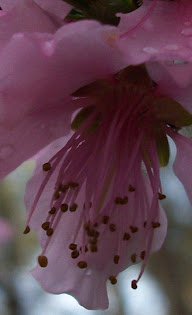As I got closer to the flowers, I noticed a colony of bugs feeding off the nectar in each little bloom.
Some of these bugs were so tiny, while others were just a fraction bigger. I don't really know what kind of bugs they were, but they were cool to photograph. A sweet lady bug also allowed me to photograph her for awhile.
The Queen Anne's Lace grows wild around here, as I guess it does in the majority of the States. It's one of my favorite wild flowers, but it wasn't till recently that I learned some of the benefits from the plant.
Some people take a teaspoon of seeds with a glass of water immediately after having sex to keep from getting pregnant.
The Queen Anne's Lace is really a wild herb and is a diuretic. It is also known as a cleansing herb because it supports the liver, stimulates urine flow, and removes waste by the kidneys. The root of this herb is used to delay menustration. Making an infusion of warm water and flower heads has been said to treat diabetes. Some take the root of a young plant and crush the root to make a tea to prevent and eliminate kidney stones. It has also been said that tea will remove worms and parasites in the human body. The thick sap can also be used for cough and congestion.
The Queens Anne's Lace contains flavonoids, essential oils, vitamins B and C, pectin, lecithin, and glutamine. The root of the herb when crushed smells just like carrot and why the Queen Anne's Lace is also called Wild Carrot. It belongs to the same family as parsley and is an ancestor to Carrots. Some have taken the flower heads of the plant and battered and fried them, claiming they taste like fried carrots. I have never tried this nor ever tried any of the tea!
There are several different fables how the Queens Anne's Lace got its name.
If you look closely in the center of the flower head, you will see one small purple flower. It is said that Queen Anne of England pricked her finger while sewing lace and the single purple flower in the center of the white cluster of flowers, signifies one single drop of her blood.
An English botanist suggests that the name did not come from Queen Anne but from Saint Anne the mother of the Virgin Mary who was a lace maker.
Some religions have used the Queens Anne's Lace in rituals and spells.
As I have said, I have never used any of the teas, nor cooked the flower heads, Ive just always enjoyed seeing the beautiful flowers. I suggest if you decide to try any of the teas, to research a little more before doing so.
NOTE: I have read that the leaves can be toxic on this plant, only the flower heads and root are edible. Please do not get the Queen Anne's Lace mixed up with the POISON HEMLOCK. As with all herbs and wild plants please research before ingesting.
Here are a few photos I took this morning. I love all the little insects on the flowers.













Oh, how I love Queen Anne's Lace! I live in small town in Northern New Jersey, quite close (unfortunately, to NYC-I hate big cities and would be the happiest woman if I could live in a rural town, but that's another story :0) Anyway, in the midst of the hustle and bustle of traffic there they grow, along driveways, in the cracks and crevices of old buildings, anywhere there's a bit of soil. A glorious sight to see that fills my heart with joy and hope. Thank you for the very interesting information, and for the incredible photos. Have a beautiful day xx
ReplyDeleteThis is a really nice post. I love all the information you provided. I've been looking into edible wild plants lately. However, I thought Queen Anne's lace and carrots were in the same family Apiaceae/Umbelliferae with the poisonous water hemlock. I'm afraid I'd get the two mixed up!
ReplyDeleteNature ID, it is in the Apiaceae family with carrot,celery,dill,fennel,hemlock,parsnip and parsley. I just worded that whole sentence wrong when I said "However, it belongs to the parsley family and is an ancestor to the Carrot family'.
ReplyDeleteI should go back and change this! Thank you for alerting me on this!
I have since added a little NOTE at the bottom of this post so others do not confuse this with hemlock.
ReplyDeleteHello Kelly! Your pictures are really great! Wow you are really into it. have you tried to apply for adsense? Your site deserves one ot has original content and nice informations. It is a refreshing sight again wish I could have time to take also those pictures and be with nature. You are blessed to have God's creation in your midst. I am staying in a city so pictures like these is an awesome sight. God bless you and continue a Job well done my friend!
ReplyDeleteAbsolutely stunning photography. The details you captured are amazing. And I thoroughly enjoyed learning all the facts about this beautiful flower that grows here too.;)
ReplyDeletexoxo